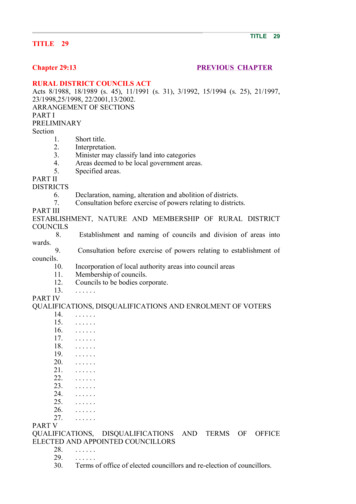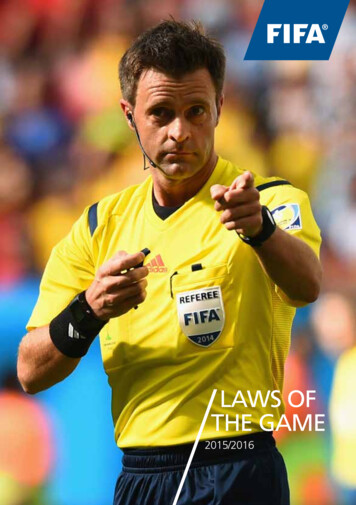
Transcription
LAWS OFTHE GAME2015/2016
Fédération Internationale de Football AssociationPresident:Joseph S. BlatterSecretary General:Jérôme ValckeAddress:FIFAFIFA-Strasse 20P.O. Box8044 ZurichSwitzerlandTelephone: 41 (0)43 222 7777Fax: 41 (0)43 222 7878Internet:www.FIFA.com
LAWS OFTHE GAME2015/2016Authorised by The International Football Association BoardThis booklet may not be reproduced or translated in wholeor in part in any manner without the permission of The IFAB.Published by Fédération Internationale de Football Association,FIFA-Strasse 20, 8044 Zurich, Switzerland
2THE INTERNATIONAL FOOTBALL ASSOCIATION BOARD orastrasse 1008032 ZurichSwitzerland 41 (0)43 222 7126www.theifab.cominfo@theifab.comThe Football AssociationThe Scottish Football AssociationThe Football Association of WalesIrish Football AssociationFIFANext meeting of the IFAB:Cardiff, 5 March 2016
3NOTES ON THE LAWS OF THE GAMEModificationsSubject to the agreement of the member association concerned and providedthe principles of these Laws are maintained, the Laws may be modified intheir application for matches for players of under 16 years of age, for womenfootballers, for veteran footballers (over 35 years of age) and for players withdisabilities.Any or all of the following modifications are permissible: size of the field of play size, weight and material of the ball width between the goalposts and height of the crossbar from the ground duration of the periods of play substitutionsFurther modifications are only allowed with the consent of the InternationalFootball Association Board.Male and FemaleReferences to the male gender in the Laws of the Game in respect of referees,assistant referees, players and officials are for simplification and apply to bothmen and women.Official languagesOn behalf of the International Football Association Board, FIFA publishes theLaws of the Game in English, French, German and Spanish. If there is anydivergence in the wording, the English text is authoritative.KeyA single line in the left-hand margin indicates new Law changes.
4
CONTENTSPageLaw61 – The Field of Play152 – The Ball183 – The Number of Players224 – The Players’ Equipment255 – The Referee296 – The Assistant Referees307 – The Duration of the Match318 – The Start and Restart of Play349 – The Ball In and Out of Play35 10 – The Method of Scoring36 11 – Offside37 12 – Fouls and Misconduct41 13 – Free Kicks45 14 – The Penalty Kick49 15 – The Throw-in51 16 – The Goal Kick53 17 – The Corner Kick55 Procedures to Determine the Winner of a Matchor Home-and-Away58 The Technical Area59 The Fourth Official and the Reserve Assistant Referee60 The Additional Assistant Referee61 Interpretation of the Laws of the Game andGuidelines for Referees5
6LAW 1 – THE FIELD OF PLAYField surfaceMatches may be played on natural or artificial surfaces, according to the rulesof the competition.The colour of artificial surfaces must be green.Where artificial surfaces are used in either competition matches betweenrepresentative teams of member associations affiliated to FIFA or internationalclub competition matches, the surface must meet the requirements of the FIFAQuality Concept for Football Turf or the International Artificial Turf Standard,unless special dispensation is given by FIFA.Field markingsThe field of play must be rectangular and marked with lines. These lines belongto the areas of which they are boundaries.The two longer boundary lines are called touch lines. The two shorter lines arecalled goal lines.The field of play is divided into two halves by a halfway line, which joins themidpoints of the two touch lines.The centre mark is indicated at the midpoint of the halfway line. A circle with aradius of 9.15 m (10 yds) is marked around it.Marks may be made off the field of play, 9.15 m (10 yds) from the cornerarc and at right angles to the goal lines and the touch lines, to ensure thatdefending players retreat this distance when a corner kick is being taken.
LAW 1 – THE FIELD OF PLAYDimensionsThe length of the touch line must be greater than the length of the goal line.Length (touch line):Width (goal line):minimummaximumminimummaximum90 m120 m45 m90 m(100 yds)(130 yds)(50 yds)(100 yds)All lines must be of the same width, which must be not more than12 cm (5 ins).International 0 m110 m64 m75 m(110 yds)(120 yds)(70 yds)(80 yds)The goal areaTwo lines are drawn at right angles to the goal line, 5.5 m (6 yds) from theinside of each goalpost. These lines extend into the field of play for a distanceof 5.5 m (6 yds) and are joined by a line drawn parallel with the goal line. Thearea bounded by these lines and the goal line is the goal area.7
8LAW 1 – THE FIELD OF PLAYThe penalty areaTwo lines are drawn at right angles to the goal line, 16.5 m (18 yds) from theinside of each goalpost. These lines extend into the field of play for a distanceof 16.5 m (18 yds) and are joined by a line drawn parallel with the goal line.The area bounded by these lines and the goal line is the penalty area.Within each penalty area, a penalty mark is made 11 m (12 yds) from themidpoint between the goalposts and equidistant to them.An arc of a circle with a radius of 9.15 m (10 yds) from the centre of eachpenalty mark is drawn outside the penalty area.FlagpostsA flagpost, not less than 1.5 m (5 ft) high, with a non-pointed top and a flagmust be placed at each corner.Flagposts may also be placed at each end of the halfway line, not less than 1 m(1 yd) outside the touch line.The corner arcA quarter circle with a radius of 1 m (1 yd) from each corner flagpost is drawninside the field of play.
LAW 1 – THE FIELD OF PLAYGoalsA goal must be placed on the centre of each goal line.A goal consists of two upright posts equidistant from the corner flagposts andjoined at the top by a horizontal crossbar. The goalposts and crossbar mustbe made of wood, metal or other approved material. They must be square,rectangular, round or elliptical in shape and must not be dangerous to players.The distance between the posts is 7.32 m (8 yds) and the distance from thelower edge of the crossbar to the ground is 2.44 m (8 ft).2.44 m(8 ft)7.32 m (8 yds)9
10LAW 1 – THE FIELD OF PLAYThe position of the goalposts in relation to the goal line must be according tothe graphics below.If the shape of the goalposts is square (viewed from above), the sides must beparallel or perpendicular to the goal line. The sides of the crossbar must beparallel or perpendicular to the field plane.If the shape of the goalposts is elliptical (viewed from above), the longest axismust be perpendicular to the goal line. The longest axis of the crossbar mustbe parallel to the field plane.If the shape of the goalposts is rectangular (viewed from above), the longestside must be perpendicular to the goal line. The longest side of the crossbarmust be parallel to the field plane.
LAW 1 – THE FIELD OF PLAY11Both goalposts and the crossbar have the same width and depth, whichdo not exceed 12 cm (5 ins). The goal lines must be of the same width asthe goalposts and the crossbar. Nets may be attached to the goals and theground behind the goal, provided that they are properly supported and do notinterfere with the goalkeeper.The goalposts and crossbars must be white.SafetyGoals must be anchored securely to the ground. Portable goals may only beused if they satisfy this requirement.
LAW 1 – THE FIELD OF PLAYThe field of playCORNER FLAGPOST(compulsory)GOAL LINEGOAL AREAPENALTY MARKTOUCH LPENALTY ARCCENTRE CIRCLEINEFLAGPOST(optional)HALFWAY LINECH LINECENTRE MARKTOU12PENALTY AREAGOAL LINEOPTIONAL MARKOPTIONALMARKCORNER ARCCorner flagpostFlag to be not less than1.5 m/5 ft high with anon-pointed topCorner arcCorner flagpost is compulsoryLines to be not morethan 12 cm/5 inswide
LAW 1 – THE FIELD OF PLAY13Metric measurementsWidth:Maximum 90 mMinimum90mMinimum 45 mimum120 mRadius:9.15 mgth:Max9.15 m16.5 mLen11 m9.15 m5.5 m9.15 m16.5 m7.32 m1 m radius5.5 mImperial measurementsWidth:Maximum 100 ydsMinimum100 ydsMinimum 50 ydsimum130ydsRadius:10 ydsgth:Max10 yds18 ydsLen12 yds10 yds6 yds10 yds18 yds8 yds6 yds1 yd radius
14LAW 1 – THE FIELD OF PLAYDecisions of the International F.A. BoardDecision 1Where a technical area exists, it must meet the requirements approved by theInternational F.A. Board, which are contained in the section of this publicationentitled The Technical Area.Decision 2Where goal-line technology (GLT) is used, modifications to the goal frame maybe allowed. They must be in accordance with the specifications stipulated inthe FIFA Quality Programme for GLT and according to the above description,“Goals”.
LAW 2 – THE BALL15Qualities and measurementsThe ball is: spherical made of leather or other suitable material of a circumference of not more than 70 cm (28 ins) and not less than68 cm (27 ins) not more than 450 g (16 oz) and not less than 410 g (14 oz) in weight atthe start of the match of a pressure equal to 0.6 – 1.1 atmosphere (600 – 1,100 g/cm2) at sealevel (8.5 lbs/sq in – 15.6 lbs/sq in)Replacement of a defective ballIf the ball bursts or becomes defective during the course of a match: the match is stopped the match is restarted by dropping the replacement ball at the place wherethe original ball became defective, unless play was stopped inside the goalarea, in which case the referee drops the replacement ball on the goal arealine parallel to the goal line at the point nearest to where the original ballwas located when play was stoppedIf the ball bursts or becomes defective during a penalty kick or during kicksfrom the penalty mark as it moves forward and before it touches any player orthe crossbar or goalposts: the penalty kick is retakenIf the ball bursts or becomes defective whilst not in play at a kick-off, goal kick,corner kick, free kick, penalty kick or throw-in: the match is restarted accordinglyThe ball may not be changed during the match without the authority of thereferee.
16LAW 2 – THE BALLDecisions of the International F.A. BoardDecision 1In addition to the requirements of Law 2, acceptance of a ball for use inmatches played in an official competition organised under the auspices of FIFAor the confederations is conditional upon the ball bearing one of the followingmarks: FIFA Quality PRO FIFA Quality IMS - INTERNATIONAL MATCHBALL STANDARDBalls carrying previous quality marks such as “FIFA Approved”, “FIFAInspected” or “International Match Standard” may be used in aforementionedcompetitions until July 2017.Such a logo on a ball indicates that it has been tested officially and found tobe in compliance with specific technical requirements, different for each logoand additional to the minimum specifications stipulated in Law 2. The list ofthe additional requirements specific to each of the respective logos must beapproved by the International F.A. Board. The institutes conducting the testsare subject to the approval of FIFA.Member association competitions may also require the use of balls bearing anyone of these three logos.Decision 2In matches played in an official competition organised under the auspices ofFIFA, the confederations or the member associations, no form of commercialadvertising on the ball is permitted, except for the emblem of the competition,the competition organiser and the authorised trademark of the manufacturer.The competition regulations may restrict the size and number of suchmarkings.
LAW 2 – THE BALLDecision 3Where goal-line technology (GLT) is used, balls with integrated technologyare allowed, but they must either be “FIFA APPROVED”, “FIFA INSPECTED” or“INTERNATIONAL MATCHBALL STANDARD” (see “Decision 1”).17
18LAW 3 – THE NUMBER OF PLAYERSNumber of PlayersA match is played by two teams, each consisting of not more than elevenplayers, one of whom is the goalkeeper. A match may not start if either teamconsists of fewer than seven players.Number of substitutionsOfficial competitionsUp to a maximum of three substitutes may be used in any match played in anofficial competition organised under the auspices of FIFA, the confederations orthe member associations.The rules of the competition must state how many substitutes may benominated, from three up to a maximum of twelve.Other matchesIn national “A” team matches, up to a maximum of six substitutes may beused.In all other matches, a greater number of substitutes may be used providedthat: the teams concerned reach agreement on a maximum number the referee is informed before the matchIf the referee is not informed, or if no agreement is reached before the match,no more than six substitutes are allowed.Return SubstitutionsThe use of return substitutions is only permitted in the lowest levels (grassroots/recreational) of football, subject to the agreement of the member associationconcerned.
LAW 3 – THE NUMBER OF PLAYERS19Substitution procedureIn all matches, the names of the substitutes must be given to the referee priorto the start of the match. Any substitute whose name is not given to thereferee at this time may not take part in the match.To replace a player with a substitute, the following conditions must beobserved: the referee must be informed before any proposed substitution is made the substitute only enters the field of play after the player being replacedhas left and after receiving a signal from the referee the substitute only enters the field of play at the halfway line and during astoppage in the match the substitution is completed when a substitute enters the field of play from that moment, the substitute becomes a player and the player he hasreplaced becomes a substituted player the substituted player takes no further part in the match, except wherereturn substitutions are permitted all substitutes are subject to the authority and jurisdiction of the referee,whether called upon to play or notChanging the goalkeeperAny of the other players may change places with the goalkeeper, provided that: the referee is informed before the change is made the change is made during a stoppage in the match
20LAW 3 – THE NUMBER OF PLAYERSInfringements and sanctionsIf a substitute or substituted player enters the field of play without the referee’spermission: the referee stops play (although not immediately if the substitute orsubstituted player does not interfere with play) the referee cautions him for unsporting behaviour and orders him to leavethe field of play if the referee has stopped play, it is restarted with an indirect free kick forthe opposing team from the position of the ball at the time of the stoppage(see Law 13 – Position of free kick)If a named substitute enters the field of play instead of a named player at thestart of the match and the referee is not informed of this change: the referee allows the named substitute to continue the match no disciplinary sanction is taken against the named substitute the number of substitutions allowed by the offending team is not reduced the referee reports the incident to the appropriate authoritiesIf a player changes places with the goalkeeper without the referee’s permissionbefore the change is made: the referee allows play to continue the referee cautions the players concerned when the ball is next out of playIn the event of any other infringements of this Law: the players concerned are cautioned the match is restarted with an indirect free kick, to be taken by a player ofthe opposing team from the position of the ball at the time of the stoppage(see Law 13 – Position of free kick)
LAW 3 – THE NUMBER OF PLAYERSPlayers and substitutes sent offA player who has been sent off before the kick-off may be replaced only byone of the named substitutes.A named substitute who has been sent off, either before the kick-off or afterplay has started, may not be replaced.21
22LAW 4 – THE PLAYERS’ EQUIPMENTSafetyA player must not use equipment or wear anything that is dangerous tohimself or another player (including any kind of jewellery).Basic equipmentThe basic compulsory equipment of a player comprises the following separateitems: a jersey or shirt with sleeves – if undergarments are worn, the colour of thesleeve must be the same main colour as the sleeve of the jersey or shirt shorts – if undershorts or tights are worn, they must be of the same maincolour as the shorts stockings – if tape or similar material is applied externally it must be thesame colour as that part of the stocking it is applied to shinguards footwearShinguards are covered entirely by the stockingsare made of rubber, plastic or a similar suitable materialprovide a reasonable degree of protectionColours The two teams must wear colours that distinguish them from each otherand also the referee and the assistant refereesEach goalkeeper must wear colours that distinguish him from the otherplayers, the referee and the assistant referees
LAW 4 – THE PLAYERS’ EQUIPMENT23Infringements and sanctionsIn the event of any infringement of this Law: play need not be stopped the player at fault is instructed by the referee to leave the field of play tocorrect his equipment the player leaves the field of play when the ball next ceases to be in play,unless he has already corrected his equipment any player required to leave the field of play to correct his equipmentmust not re-enter without the referee’s permission the referee checks that the player’s equipment is correct before allowinghim to re-enter the field of play the player is only allowed to re-enter the field of play when the ball is outof playA player who has been required to leave the field of play because of aninfringement of this Law and who re-enters the field of play without thereferee’s permission must be cautioned.Restart of playIf play is stopped by the referee to administer a caution: the match is restarted by an indirect free kick taken by a player of theopposing team from the place where the ball was located when the refereestopped the match (see Law 13 – Position of free kick)
24LAW 4 – THE PLAYERS’ EQUIPMENTDecisions of the International F.A. BoardDecision 1Basic compulsory equipmentThe basic compulsory equipment must not have any political, religious orpersonal slogans, statements or images.The team of a player whose basic compulsory equipment has political, religiousor personal slogans or, statements or images will be sanctioned by thecompetition organiser or by FIFA.UndergarmentsPlayers must not reveal undergarments that show political, religious, personalslogans, statements or images, or advertising other than the manufacturerlogo.A player/team of a player that reveals an undergarment that shows political,religious, personal slogans, statements or images, or advertising other than themanufacturer logo will be sanctioned by the competition organiser or by FIFA.
LAW 5 – THE REFEREE25The authority of the refereeEach match is controlled by a referee who has full authority to enforce theLaws of the Game in connection with the match to which he has beenappointed.Powers and dutiesThe Referee: enforces the Laws of the Game controls the match in cooperation with the assistant referees and, whereapplicable, with the fourth official ensures that any ball used meets the requirements of Law 2 ensures that the players’ equipment meets the requirements of Law 4 acts as timekeeper and keeps a record of the match stops, suspends or abandons the match, at his discretion, for anyinfringements of the Laws stops, suspends or abandons the match because of outsideinterference of any kind stops the match if, in his opinion, a player is seriously injured and ensuresthat he is removed from the field of play. An injured player may only returnto the field of play after the match has restarted allows play to continue until the ball is out of play if a player is, in hisopinion, only slightly injured ensures that any player bleeding from a wound leaves the field of play. Theplayer may only return on receiving a signal from the referee, who must besatisfied that the bleeding has stopped allows play to continue when the team against which an offence has beencommitted will benefit from such an advantage and penalises the originaloffence if the anticipated advantage does not ensue at that time punishes the more serious offence when a player commits more than oneoffence at the same time takes disciplinary action against players guilty of cautionableand sending-off offences. He is not obliged to take this action immediatelybut must do so when the ball next goes out of play
26LAW 5 – THE REFEREE takes action against team officials who fail to conduct themselves in aresponsible manner and may, at his discretion, expel them from the field ofplay and its immediate surroundsacts on the advice of the assistant referees regarding incidents that he hasnot seenensures that no unauthorised persons enter the field of playindicates the restart of the match after it has been stoppedprovides the appropriate authorities with a match report, which includesinformation on any disciplinary action taken against players and/or teamofficials and any other incidents that occurred before, during or after thematchDecisions of the refereeThe decisions of the referee regarding facts connected with play, includingwhether or not a goal is scored and the result of the match, are final.The referee may only change a decision on realising that it is incorrect or, at hisdiscretion, on the advice of an assistant referee or the fourth official, providedthat he has not restarted play or terminated the match.
LAW 5 – THE REFEREE27Decisions of the International F.A. BoardDecision 1A referee (or where applicable, an assistant referee or fourth official) is not heldliable for:any kind of injury suffered by a player, official or spectatorany damage to property of any kindany other loss suffered by any individual, club, company, association orother body, which is due or which may be due to any decision that he maytake under the terms of the Laws of the Game or in respect of the normalprocedures required to hold, play and control a match.Such decisions may include: a decision that the condition of the field of play or its surrounds or that theweather conditions are such as to allow or not to allow a match to takeplace a decision to abandon a match for whatever reason a decision as to the suitability of the field equipment and ball used during amatch a decision to stop or not to stop a match due to spectator interference orany problem in spectator areas a decision to stop or not to stop play to allow an injured player to beremoved from the field of play for treatment a decision to require an injured player to be removed from the field of playfor treatment a decision to allow or not to allow a player to wear certain apparel orequipment a decision (where he has the authority) to allow or not to allow any persons(including team or stadium officials, security officers, photographers orother media representatives) to be present in the vicinity of the field of play any other decision that he may take in accordance with the Laws ofthe Game or in conformity with his duties under the terms of FIFA,confederation, member association or league rules or regulations underwhich the match is played
28LAW 5 – THE REFEREEDecision 2In tournaments or competitions where a fourth official is appointed, hisrole and duties must be in accordance with the guidelines approved by theInternational F.A. Board, which are contained in this publication.Decision 3Where goal-line technology (GLT) is used (subject to the respective competitionrules), the referee has the duty to test the technology’s functionality before thematch. The tests to be performed are set out in the FIFA Quality Programmefor GLT Testing Manual. If the technology does not function in accordance withthe Testing Manual, the referee must not use the GLT system and must reportthis incident to the respective authority.
LAW 6 – THE ASSISTANT REFEREES29DutiesTwo assistant referees may be appointed whose duties, subject to the decisionof the referee, are to indicate: when the whole of the ball leaves the field of play which team is entitled to a corner kick, goal kick or throw-in when a player may be penalised for being in an offside position when a substitution is requested when misconduct or any other incident occurs out of the view of thereferee when offences have been committed whenever the assistant refereeshave a better view than the referee (this includes, in certain circumstances,offences committed in the penalty area) whether, at penalty kicks, the goalkeeper moves off the goal line before theball is kicked and if the ball crosses the lineAssistanceThe assistant referees also assist the referee in controlling the match inaccordance with the Laws of the Game. In particular, they may enter the fieldof play to help control the 9.15 m (10 yds) distance.In the event of undue interference or improper conduct, the referee willrelieve an assistant referee of his duties and make a report to the appropriateauthorities.
30LAW 7 – THE DURATION OF THE MATCHPeriods of playThe match lasts two equal periods of 45 minutes, unless otherwise mutuallyagreed between the referee and the two teams. Any agreement to alter theduration of the periods of play (e.g. to reduce each half to 40 minutes becauseof insufficient light) must be made before the start of play and must complywith competition rules.Half-time intervalPlayers are entitled to an interval at half-time.The half-time interval must not exceed 15 minutes.Competition rules must state the duration of the half-time interval.The duration of the half-time interval may be altered only with the consent ofthe referee.Allowance for time lostAllowance is made in either period for all time lost through: substitutions assessment of injury to players removal of injured players from the field of play for treatment wasting time any other causeThe allowance for time lost is at the discretion of the referee.Penalty kickIf a penalty kick has to be taken or retaken, the duration of either half isextended until the penalty kick is completed.Abandoned matchAn abandoned match is replayed unless the competition rules provideotherwise.
LAW 8 – THE START AND RESTART OF PLAY31Definition of kick-offA kick-off is a way of starting or restarting play: at the start of the match after a goal has been scored at the start of the second half of the match at the start of each period of extra time, where applicableA goal may be scored directly from the kick-off.ProcedureBefore a kick-off at the start of the match or extra time a coin is tossed and the team that wins the toss decides which goal it willattack in the first half of the match. the other team takes the kick-off to start the match. the team that wins the toss takes the kick-off to start the second half of thematch. in the second half of the match, the teams change ends and attack theopposite goals.Kick-off after a team scores a goal, the kick-off is taken by the other team. all players must be in their own half of the field of play the opponents of the team taking the kick-off are at least 9.15 m (10 yds)from the ball until it is in play the ball must be stationary on the centre mark the referee gives a signal the ball is in play when it is kicked and moves forward the kicker must not touch the ball again until it has touched another player
32LAW 8 – THE START AND RESTART OF PLAYInfringements and sanctionsIf the player taking the kick-off touches the ball again before it has touchedanother player: an indirect free kick is awarded to the opposing team to be taken from theposition of the ball when the infringement occurred (see Law 13 – Positionof free kick)In the event of any other infringement of the kick-off procedure: the kick-off is retakenDefinition of dropped ballA dropped ball is a method of restarting play when, while the ball is still in play,the referee is required to stop play temporarily for any reason not mentionedelsewhere in the Laws of the Game.ProcedureThe referee drops the ball at the place where it was located when play wasstopped, unless play was stopped inside the goal area, in which case thereferee drops the ball on the goal area line parallel to the goal line at the pointnearest to where the ball was located when play was stopped.Play restarts when the ball touches the ground.
LAW 8 – THE START AND RESTART OF PLAY33Infringements and sanctionsThe ball is dropped again: if it is touched by a player before it makes contact with the ground if the ball leaves the field of play after it makes contact with the ground,without a player touching itIf the ball enters the goal: if a dropped ball is kicked directly into the opponents’ goal, a goal kick isawarded if a dropped ball is kicked directly into the team’s own goal, a corner kick isawarded to the opposing team
34LAW 9 – THE BALL IN AND OUT OF PLAYBall out of playThe ball is out of play when: it has wholly crossed the goal line or touch line whether on the ground orin the air play has been stopped by the refereeBall in playThe ball is in play at all other times, including when: it rebounds off a goalpost, crossbar or corner flagpost and remains in thefield of play it rebounds off either the referee or an assistant referee when they are onthe field of playBall rebounding fromcorner flagpost,goalpost or crossbar intofield of play is in playBall in playBall out of playBall in playBall in playBall in play
LAW 10 – THE METHOD OF SCORING35Goal scoredA goal is scored when the whole of the ball passes over the goal line, betweenthe goalposts and under the crossbar, provided that no infringement of theLaws of the Game has been committed previously by the team scoring thegoal
References to the male gender in the Laws of the Game in respect of referees, assistant referees, players and officials are for simplification and apply to both men and women. Official languages On behalf of the International Football Association Board, FIFA publishes the Laws of the Game in English, French, German and Spanish. If there is any


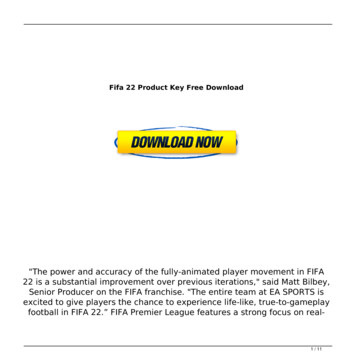
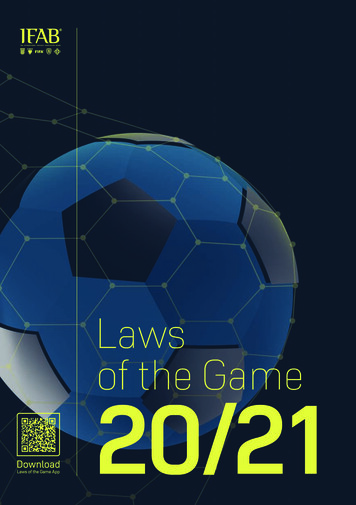
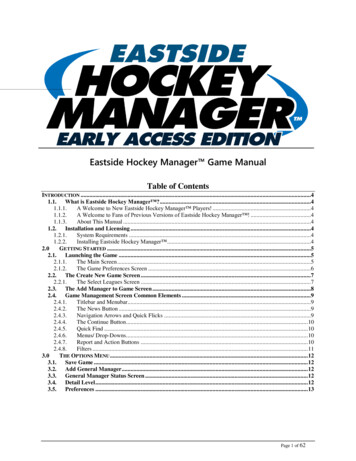
![Fifa 22 Crack Mega Keygen [32 64bit]](/img/64/dafferm.jpg)
![Fifa 22 Crack Mega License Key Full Free [Mac/Win] - DULCE XV](/img/62/xandfonz.jpg)
